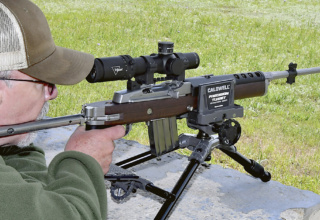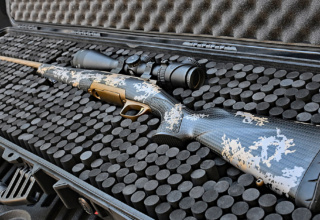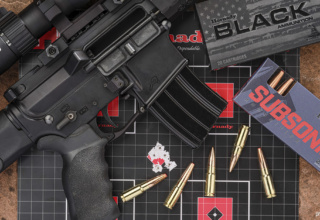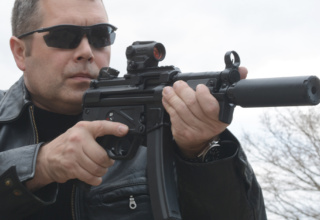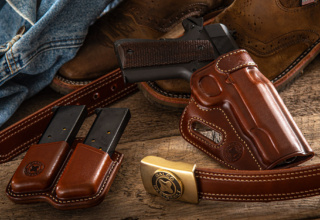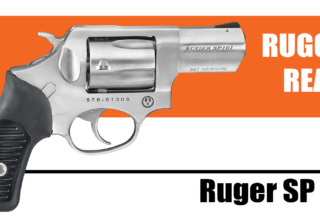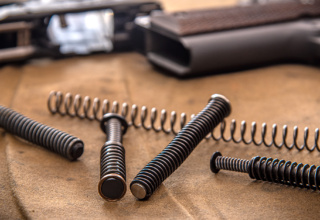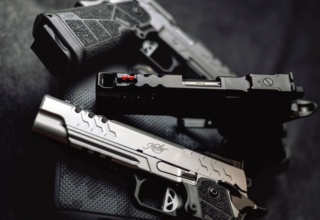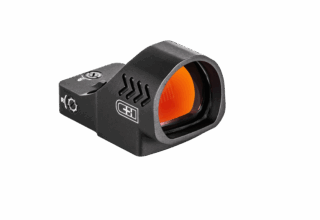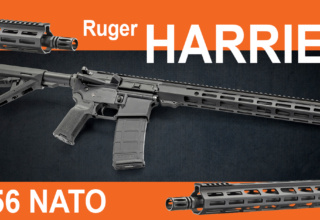Trijicon just jumped to the top of the class with its new higher-magnification LPVO
by Mike Dickerson
The LPVO market is changing fast.
Until recently, LPVOs (low power variable optics) were basically downsized riflescopes that typically had low magnification, small objective lenses and reticles designed primarily for fast target engagement versus long-range precision. They offered somewhat limited utility and topped out at 6x or 8x magnification. That’s changing with newer LPVOs offering significant enhancements in magnification, reticles, illumination, turrets, and versatility.
Now, Trijicon has unveiled a new LPVO, the Credo 1-10×28, that does all of the above, and then some. The first thing you’ll notice when picking up the Credo is its heft and ruggedness. Make no mistake about it: this scope is built Trijicon tough. More than a few current and former members of the U.S. military know what I mean by that, as Trijicon has long been a supplier of robustly built optics to the military. The Trijicon ACOG, for example, earned a reputation for being virtually bulletproof, and the Marines chose Trijicon’s VCOG (Variable Combat Optical Gunsight) a few years ago as their go-to LPVO.
It’s no accident that some of that military optic know-how has found its way into Trijicon optics geared for the civilian and law enforcement markets. The new Credo exhibits some of that expertise in a package that will nicely cover everything from a close-quarters defensive engagement to relatively long-range precision work. While this LPVO is certainly at home on AR platforms for defensive use, it’s versatile enough to serve as a hunting scope as well.
Most of the Credo’s LPVO peers offer 6x or 8x magnification at the high end, 30mm tubes, and 24mm objective lenses. The Credo, in contrast, offers 10x magnification, has a 28mm objective lens, and is built on a 34 mm tube to make the most of available light. There are a limited number of 1-10×28 LPVOs out there, but few are built to this standard of quality and fewer still are first focal plane scopes with MRAD reticles and adjusters.
That’s an important distinction when you consider the Credo’s Segmented Circle Enhanced reticle. As with any first focal plane scope, reticle and subtension size increase as magnification increases so you are not hamstrung by subtension hashes being accurate at only one magnification setting. This matters little when the scope is dialed down to 1x. The subtensions are barely visible at that setting, but the segmented “circle of death” center of the reticle gives you a very fast aiming solution in a CQB situation. As you dial up the power, the reticle and subtensions grow in size and remain accurate at any magnification, providing quick and precise holds for windage and elevation at distance.
Trijicon actually offers two versions of this scope. The Credo HX 1-10×28 has less-aggressive styling with an MOA reticle and adjustment turrets. The subject of this review, the Credo 1-10×28 model, has more tactical styling with an MRAD reticle and adjustment turrets, and is designed more for tactical and competitive use. The HX leans more in the direction of a hunting scope, but both models can serve well in either role. Which one is right for you comes down to a choice between MOA or MRAD.
Visibility of the center dot and segmented circle portions of the reticle is enhanced with LED variable-brightness illumination powered by a CR2032 battery and controlled by an adjuster on the left side of the scope. There are five red and five green illumination settings, with “off” detents in between each setting. This provides a nearly ideal aiming solution for close-range shooting. Shooters who are new to LPVOs may initially find that it’s not quite as fast as a red dot optic, but with practice and the scope set at a low-magnification setting, you’ll find this LPVO will provide a very fast aiming solution. Battery life is rated at 39 hours with red illumination and 94 hours with green illumination.
Of course, you’re not limited to using the subtensions in the reticle. You can dial up corrections using the exposed return-to-zero elevation turret and the capped windage adjustment turret. Both are clearly marked in 0.1 MRAD increments. Range of adjustment is a generous 29 MRAD (or 100 MOA) of travel, providing ample room for dialing in corrections for distance or windage. In comparison, one prominent competing 1-10×28 scope offers only 15 MRAD of elevation travel.
The top of each turret is aggressively knurled, providing a solid grip to manipulate the turret in any weather. Each audible click of adjustment is smooth and crisp, with no hint of mushiness. The diopter on the eyepiece or ocular lens doesn’t lock in place, but it requires sufficient force to turn that it’s very unlikely to be accidentally moved out of position. You can also reposition the short magnification throw lever to best suit your needs.
The only thing missing on this scope is an adjustment for parallax, which isn’t really a high priority for the situations in which many shooters will use a LPVO. This scope is optimized for tactical employment, which means most shooters won’t have time to adjust for parallax, and adding more parts to a LPVO just adds more weight.
In range testing, with the scope mounted onto an AR clamped into a Caldwell Precision Turret rest, the scope’s elevation and windage adjustments tracked precisely and were spot-on.
The scope’s versatility shone through in testing with two different rifles using different scope-mounting methods. The scope worked great atop the new folding Ruger Mini-14, mounted with Talley Tactical rings on a short Picatinny rail provided by Ruger. The scope proved to be ideal for testing on Smith & Wesson’s new M&P 15 Sport III rifle using the innovative Trijicon Cantilever Quick Release Mount.
So, how does the Credo 1-10×28 stack up against competing scopes with the same magnification range? By most standards of measurement, I would put the Credo at the top of the class. Overall optical quality of this scope is excellent. I noticed some slight distortion at the edges, primarily at the highest magnification, but the scope has great resolution and low-light performance for a LPVO. I didn’t measure any of this scientifically. I evaluated the scope using the only instrument that matters to me: the standard-issue human eyeball. To my eye, this Credo is a winner thanks to its anti-reflective, multi-coated glass, 34mm tube, and relatively large objective lens.
Eye relief on this scope ranges from 3.2 inches to 3.9 inches, depending on magnification. Field of view is 116.6 feet at 1x and 11.7 feet at 10x at 100 yards. Those numbers are comparable to or better than the numbers for most competing 1-10 LPVOs.
Mounted atop any gun, the Credo 1-10×28 is an imposing piece of glass. Even so, it weighs just 21.2 ounces. I’m not sure how Trijicon engineers pulled this off, but that weight compares favorably to competing models and is actually 4.4 ounces less than the weight of the Credo 1-8×28 LPVO.
With an MSRP of $2,150, the Credo 1-10×28 isn’t exactly cheap, but I consider it a bargain for a LPVO that’s built like a tank and is equally at home shooting near and far.
Trijicon Credo 1-10x28mm Specifications
- Magnification: 1-10x
- Objective Lens: 28 mm
- Focal Plane: first
- Tube Diameter: 34 mm
- Reticle: Segmented circle enhanced reticle
- Field of View (ft. @ 100m): 116.6 – 11.7
- Eye Relief: 3.2-3.9 in.
- Exit Pupil: .32 – .11 in.
- Length: 10.1 in.
- Weight: 21.2 oz.
- Elevation Adjustment Knob: 0.1 MRAD
- Illumination Control: rotary dial
- Wind/Elevation Adjustment Range: 29 MRAD
- Parallax/Focus: none
- Nitrogen Filled: yes
- Operating Temperature Range: -20º F to +140º F
- Waterproof/Fogproof: yes
- Battery: CR2032
- Warranty: Trijicon lifetime warranty/5-year electronics
- MSRP: $2,150
- TESTED: Riton 5 Primal 3-18×50 Riflescope - December 24, 2025
- Pelican Re-Set: One Rifle Case to Rule Them All? - October 8, 2025
- Hornady’s New .338 ARC: The .300 Blackout Killer? - June 2, 2025




